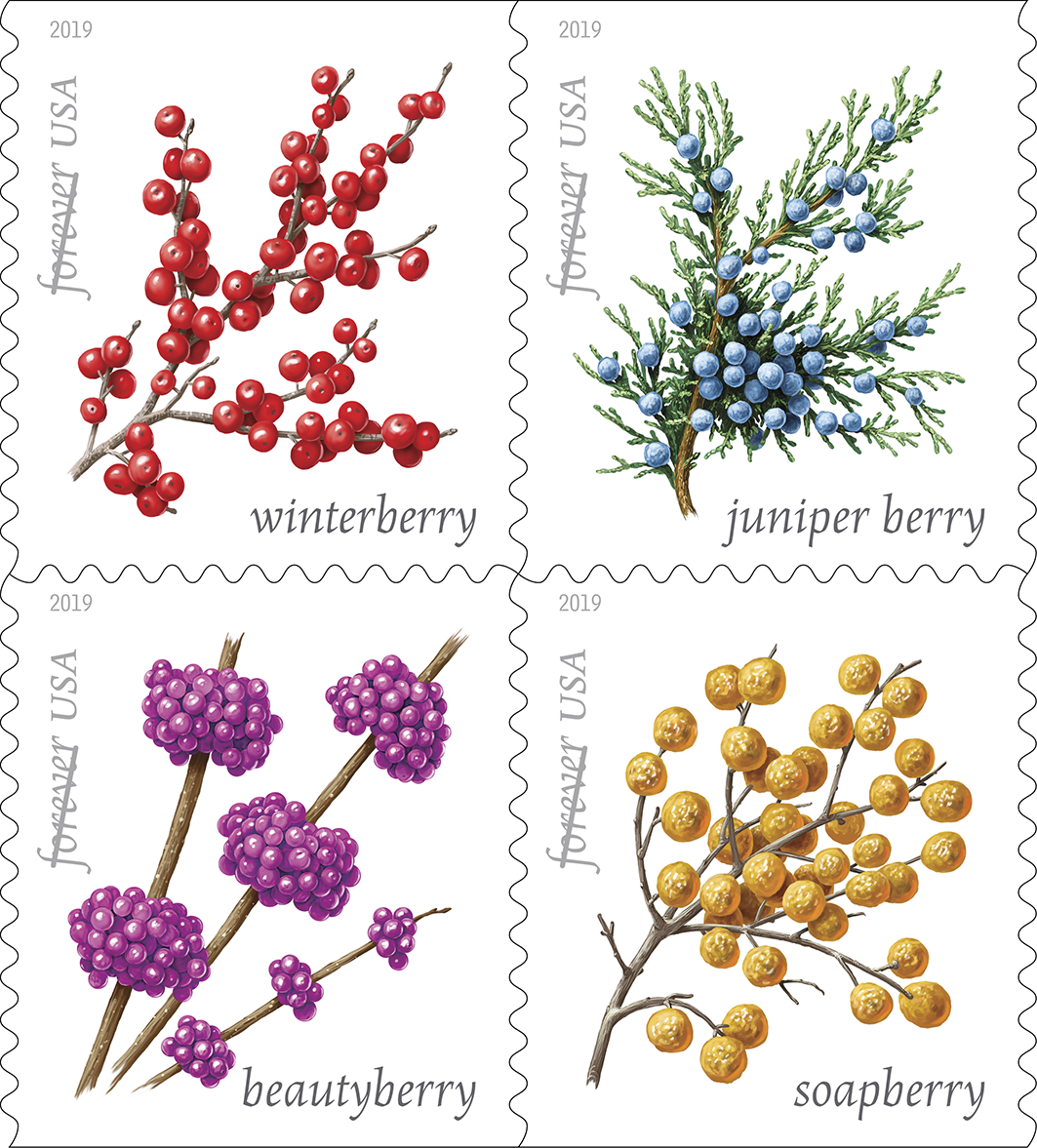September 17, 2019
Winter Berries Forever Stamps On Sale Today Nationwide
New Stamps Spotlight the Bold Colors and Rich Textures of Berries

TULSA — With the release of the Winter Berries Forever stamps, the U.S. Postal Service celebrates four of winter’s small yet vibrant offerings: the winterberry (Ilex verticillata), the juniper berry (Juniperus communis), the beautyberry (Callicarpa americana), and the soapberry (Sapindus saponaria). The stamps were issued at a First Day of Issue stamp dedication ceremony held in the A.R. & Marylouise Tandy Floral Terraces at the Tulsa Botanic Garden today.
“I can’t think of a better place for the United States Postal Service to unveil a collection of stamps to celebrate one of nature’s unique and colorful wonderments,” said Steven Phelps, acting vice president, Pricing and Costing, U.S. Postal Service. “Although much of nature’s bold imagery gets muted by winter’s cold temperatures and snowfall, the four colorful berries that we are highlighting on our new stamps are sure to help brighten the season.”
The stamp art features highly detailed botanical portraits of each plant that highlight the bold colors and rich textures of their berries. Artist Steve Buchanan worked with Art Director Antonio Alcalá to create these four new stamps.
Barbara Sturdivant, chair, Tulsa Botanic Garden Board of Directors, and Todd Lasseigne, president and CEO, Tulsa Botanic Garden, joined Phelps in the ceremony, along with Raymond Red Corn, assistant principal chief, Osage Nation.
News of the stamps is being shared on social media using the hashtag #WinterBerriesStamps. Followers of the Postal Service’s Facebook page can view the ceremony live at facebook.com/usps.
The Winter Berries booklet of 20 stamps are being issued as Forever stamps, meaning they will always be equal in value to the current First-Class Mail 1-ounce price.
Background
Seen throughout the eastern United States, the common winterberry sports dense clumps of small red berries on its bare branches in the winter. A variety of deciduous holly, this attractive shrub loses all of its leaves after the first frost. The winterberry can grow up to 15 feet tall and is a popular addition to yards and gardens. In the winter, its bright fruit becomes a valuable food source for many small mammals and more than 45 species of birds.
Native to most of the United States and Canada, the common juniper produces seeds that are not quite what they seem. The blackish-blue berries that adorn the juniper’s evergreen branches are actually small conifer cones. With tightly merged scales and a fleshy appearance, the seeds resemble, and are commonly referred to as, berries. Their bold color and distinctive, astringent flavor make them irresistible for a variety of birds and even some humans.
Perhaps the most aptly named of nature’s fruiting plants, the American beautyberry is a vivid sight throughout the southeastern United States. In late summer, small purple berries begin to grow in rounded clusters along the shrub’s drooping branches. Popular with many varieties of birds, the berries get snatched up in autumn with some persisting through winter. A native perennial, the beautyberry grows well in lush environments and can reach a height of eight feet. Its attractive berries and vigor make it a favorite for many gardeners.
Named for the sudsy froth produced by a compound found in its fruit, the soapberry tree can grow as tall as 50 feet. Sometimes called western or wingleaf soapberry, this deciduous tree bears golden yellow berries in the fall that remain throughout the winter. Though poisonous to consume, the berries have been used to make soap in various tropical regions around the world. In the United States, soapberry grows across the southern half of the country, from Arizona to South Carolina.
Postal Products
Customers may purchase stamps and other philatelic products through The Postal Store at usps.com/shop, by calling 800-STAMP24 (800-782-6724), by mail through USA Philatelic, or at Post Office locations nationwide. Forever stamps will always be equal in value to the current First-Class Mail 1‑ounce price. A video of the ceremony will be available on facebook.com/usps.
Information on ordering first-day-of-issue postmarks and covers is at usps.com/shop under “Collectors.”
The Postal Service receives no tax dollars for operating expenses and relies on the sale of postage, products and services to fund its operations
###
USPS NEWS
Media contacts
-
National
Mauresa R. Pittman
mauresa.r.pittman@usps.gov
202.268.2220 -
Local
Becky Hernandez
becky.m.hernandez@usps.gov
210.368.8582
